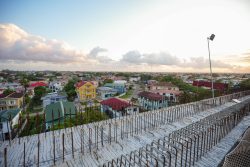In his keynote address at the Barbados Agrofest last week, President Irfaan Ali made a grand gesture toward Caribbean food security, when he announced that young Barbadians would be allocated farmland in Guyana; 50 acres to be precise. It was not the only allotment divulged, as he also mentioned awards of 50 acres for a youth-driven Blackbelly sheep project and another 50 acres for single parents, women and people with disabilities. In general, grandiloquence aside, this was an admirable promulgation and if it really works, a significant nod to food production.
What was not divulged was exactly where these 150 acres are to be allotted. Nor was there any mention of the infrastructure that would be put in place to make this agricultural push as feasible as it sounds. Usually, as the saying goes, the devil is in the details. It is well known that at present, in many areas, local farmers struggle to get their crops to market owing to lack of roads or poor maintenance where they exist. This results in significant losses between harvest and distribution that are a strain on farmers’ finances and is an area that needs urgent and proper attention.
As regards food security, the United Nations has been persistent in its calls for increased production since before 2008, warning that a lack of preparation would see the expected surge in the global population to 9.7 billion by 2050 dangerously heightening hunger and malnutrition. It did not, at that time, forecast how much more difficult the situation was likely to become with the added exigencies wrought by a global pandemic and wars. However, with full cognisance of the climate crisis, there were and still are caveats with regard to advancing agriculture.
At a very basic level there has to be understanding and acceptance that land is finite. Its usage, therefore, must always be informed by this. For the most part, commercial agriculture as currently practised (with the use of chemical fertilisers, weed killers and insecticides) significantly reduces the arability of land over time. This has led to the encroachment in forests to procure more arable land for agriculture, a much frowned upon and unsustainable practice that has caused untold damage to the environment, fuelling climate change and driving biodiversity loss. The destruction of the Amazon rainforest in Brazil, though much of it is for cattle ranching, is a case in point.
Increasingly too, today’s astute consumer is embracing organic food, is highly invested in where it comes from, how it is grown or reared and is choosing to spend only on what is found to be truly nutritious. Consequently, the need to practice smart rather than extensive agriculture is catching on; this includes urban farming, hydroponics and aquaponics.
Hydroponic farming has been around in Guyana since around 2005. It was following the Great Flood that year that the Inter-American Institute for Cooperation on Agriculture introduced small-scale hydroponic farming in this country. It possibly may have been around before. However, the number of farmers using this method for cash crops is still very small, despite a second push in 2012 under the Partners of the Americas’ ‘Farmer to Farmer’ programme, supported by USAID. Aquaponic farming, which involves a combination of fish and plant production using aquaculture and hydroponics systems, is also being done here, but by an even smaller fraction of farmers. This is despite it being widely acknowledged by agricultural scientists that these methods are more cost effective than traditional farming, adaptable to a variety of crops and climate smart. It may be the case that local authorities are yet to overcome farmers’ dependence on traditional farming knowledge, but surely incentives could be offered to deal with intractability.
That said, and given that President Ali mentioned that young Barbadian farmers are being mentored in Guyana on shadehouse food production, one wonders why more emphasis is not being placed on non-traditional farming, which would not require the awarding of 50-acre concessions. Indubitably, hydroponic farming would be a preferable method for women-headed single parent families and people with disabilities as it is less labour intensive.
Meanwhile, extending assistance with food production to Barbados should certainly be pursued. Furthermore, one must include the rest of Caricom in this if, as is being preached, Guyana is truly taking up her role once more as the breadbasket of the Caribbean. As Guyana leads this charge, however, there is a need to take cognisance of the maxim ‘work smarter, not harder’ and apply this not just to labour but also the land. Smart farming not only allows for land conservation, which in turn protects the ecosystem, but gives us access to healthier food. This fits into any green playbook and is a win-win all around.





